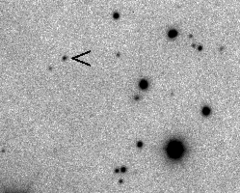52975 Cyllarus
|
| |
| Discovery[1] | |
|---|---|
| Discovered by | N. Danzl |
| Discovery site | Kitt Peak |
| Discovery date | October 12, 1998 |
| Designations | |
| MPC designation | 52975 |
Named after | Cyllarus |
| 1998 TF35 | |
| Centaur[1][2] | |
| Orbital characteristics[1] | |
| Epoch May 14, 2008 | |
| Aphelion | 35.99677890184186 |
| Perihelion | 16.20557560674432 |
| Eccentricity | 0.3791247249555059 |
| 133.98 yr | |
| 50.49319757303971 | |
| Inclination | 12.64863840704166 |
| 51.99188032439432 | |
| 300.6674691004632 | |
| Physical characteristics | |
| Dimensions | ~70 km (assumed)[3] |
| 0.07 (assumed)[3] | |
| 23.1[4] | |
| 9.3[1] | |
|
| |
52975 Cyllarus /ˈsɪlərəs/, provisionally known as 1998 TF35, is an asteroid discovered on October 12, 1998, by Nichole Danzl at the Kitt Peak Observatory near Sells, Arizona in the United States. It is named for the centaur Cyllarus of Greek mythology.
In November 2009, Mike Brown and his team using the Keck telescope took a spectrum of Cyllarus (apparent magnitude 23), giving it "the record for the faintest spectrum of a Kuiper belt object".
Cyllarus came to perihelion in September 1989.[1]
References
- 1 2 3 4 5 "JPL Small-Body Database Browser: 52975 Cyllarus (1998 TF35)" (2008-09-25 last obs).
- ↑ Marc W. Buie. "Orbit Fit and Astrometric record for 52975" (2008-09-25 using 29 observations). SwRI (Space Science Department). Retrieved 2009-11-22.
- 1 2 assumed to have a typical centaur albedo
- ↑ "AstDys (52975) Cyllarus Ephemerides". Department of Mathematics, University of Pisa, Italy. Retrieved 2009-11-22.
External links
- Orbital simulation from JPL (Java) / Horizons Ephemeris
- 52975 Cyllarus at the JPL Small-Body Database
| ||||||
| ||||||||||||||||||||||||||||
This article is issued from Wikipedia - version of the Wednesday, January 27, 2016. The text is available under the Creative Commons Attribution/Share Alike but additional terms may apply for the media files.
